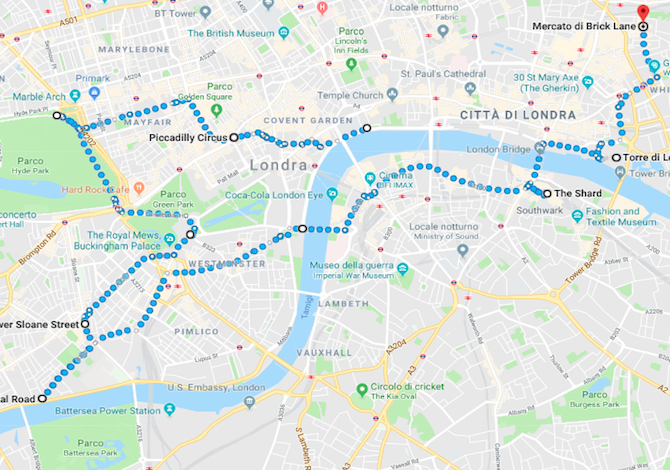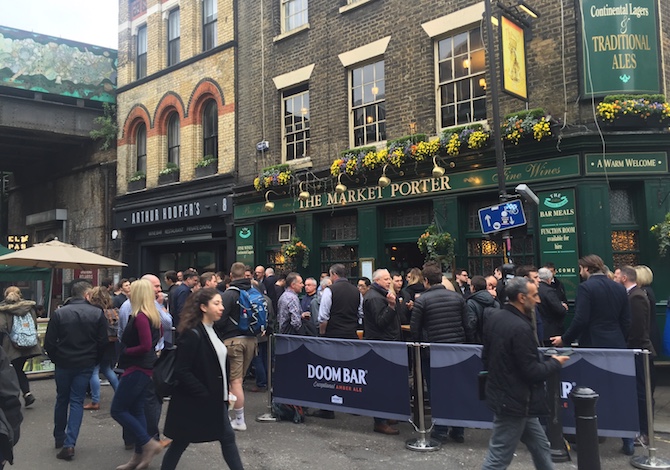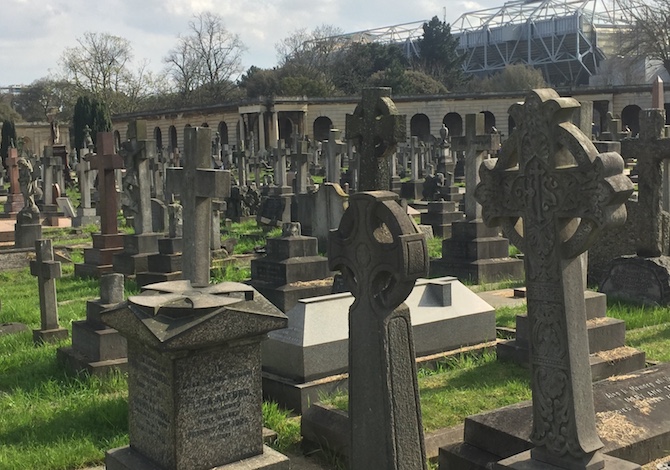It can be turned London on foot in one day, walk 20km to see (almost) everything. Or see the essentials of the City by taking a nicephysical training based on walking. We tried it and tell how to do it. Because yes, it can be done. The parks, the Thames, the City, Buckingham Palace and Trafalgar Square, but also the hipster neighborhoods. And it’s not the stuff of tourists who get around the center in 2 hours on the open ‘sightseeing’ bus; it’s more an experience: physical, sensory, mental, narrative.
London on foot in one day, walk 20km to see (almost) everything
Why see cities on foot? Of course, to get to know a city you need more time, the opportunity to stop and breathe in the atmosphere of the places, visit monuments (below, a mural on Brick Lane), museums and key buildings, stop in clubs and restaurants to understand how to eat and have fun the locals. In short, it takes days.
But if you have a few, or even just one, or if you want to have a general overview in a few hours to then explore individual neighborhoods or attractions, there’s nothing better than a long exploration on foot.
We have seen that 10 minutes of walking a week is enough to be happy, and that the WHO recommends taking 10,000 steps a day to keep fit from a cardiovascular point of view: we put ourselves to the test by walking about 20 kilometers (but wishing even more) in one day, in central London.
>> READ ALSO: Walking to lose weight: 10 tips
Can you walk around London in one day?
In our walking exploration of the English capital (above the route, more or less), which can only be partial, we passed through the unmissable points of interest such as the streets of the City, the large parks, Buckingham Palace and the attractions on the Thames. But also emerging neighborhoods such as Shoreditchthe timeless Covent Garden, the area of the new skyscrapers near Tower Bridge, some gems such as the Inner Courts.
We had already told the 6 very outdoor (and non-touristy) things to do in London. Here we are on the same wavelength, we do outdoor sports while walking around the city. but Without entering the museums, galleries, department stores and buildings with long stays, here are ours advice on the route to take, which can be done starting from any point on the map, traveling backwards, adding or removing traits at will, jumping from one point to another (perhaps using some means, it’s not a mortal sin). Just walk with a light heart and step.

This is not a forced march but a long and sometimes intricate and illogical da flaneur (but getting lost is the beauty of the journey) that in the end it will repay you amply. Tired, highly trained and happy.
>> READ ALSO: 6 tips to keep fit while walking
Da Temple a Piccadilly Circus
A good place to start is Temple tube station. As soon as they leave, tea enthusiasts can stop at the Twinings official shop, then head towards the Inner Courtsthe ‘judicial’ district of London where the courts in which cases are heard are located.
Late morning on working days vThe internal gardens of the courts are open and you can walk from one courtyard to another, all very English and soberly elegant. Recommended and surprising for anyone who wants to see an authentic London. In the area there is also the church of the Templars where sequences of the Da Vinci Code.

The Covent Garden area
From there it heads west towards the Covent Garden covered market (very touristy), zigzagging between the main arteries (Drury Lane, Bow Street) and the alleys populated with ethnic restaurants and craft shops, but also museums and theaters that stage the splendid London musicals. An obligatory passage is the Chinese quarter, north of Charing Cross, with the classic red lanterns and butchers displaying meat in the window.
One way to another it flows into Piccadilly Circusone of London’s most iconic squares.
>> READ ALSO: Walking shoes: how to choose the most suitable ones
Soho, a parish in Westminster
From Piccadilly you walk up the bend of Regent Street, a string of once-luxury, now more popular shops. Better to turn right for the Soho neighborhoodback in vogue some time after the glories of the punk era and a twenty-year decadence, where you can breathe a more sparkling and creative air, with bars and art and craft shops.
Mayfair e Hyde Park
Now you enter the northern area of the centre, the greener and more elegant one. If going up to Regent’s Park seems a bit long (but those who love history, art and literature can not miss Fitzrovia)it’s better to throw yourself on the west side of Regent Street and head towards Hyde Park, weaving through the chic streets of Mayfair.
Once in the park (no need to enter Marble Arch, which is nothing special) you can also get around by bike (it’s really big) by renting them by the hour at some entrances. Don’t miss the Princess Diana Memorial, a walkable fountain by the Serpentine Lake, ideal for a stopover and to cool your feet by walking on the stones wet with cold water.
>> READ ALSO: By bike in the city: 10 practical tips for safety
Detour to Notting Hill
A nice detour (preferably by bike) is to the northwest of the park towards Notting Hill, a bijou district full of bars and restaurants bistrot eco-bio and home to the legendary Portobello Market, where you can find everything from vintage clothes to low-priced sneakers, from antiques to Valencian paella (the best stalls are those under the overpass at the end of Portobello road, right and left).
Parks, palaces, squares
Now heading south, passing through the ‘real’ area of London, i.e. the Wellington Arch, Green Park, Buckingham Palace, St. James Park and the flower beds. Up to the Horse Guards buildings, then Trafalgar Squarea symbol of English pride, and then down to the Thames, in the area of Big Ben and the Palace of Westminster, another London icon (above a photo of the Transcontinental Race, which starts from the heart of the City).
>> READ ALSO: 10 small tools to keep fit at home
South Bank, Tower Bridge, Brick Lane
The best side for strolling on the Thames is the one to the south, where there is a long and wide pedestrian promenade that touches the most interesting points: the Ferris wheel, the Shakespeare Globe theater (the wooden and straw replica of the Elizabethan theater where the bard staged his works) the Tate Modern gallery ( take a cappuccino on the top floor for a view over the whole city) and the charming stone buildings of the port docks, which today house galleries, public and local institutions.
On the left all the most famous bridges flow, from Blackfriars to the Millennium to London Bridge.

Gourmet market and business district
Il Borough Market, under the railway bridge, is the ideal destination for a quality meal while social watching among the Londoners and workers of the financial district of the surrounding skyscrapers such as the Shard, the tallest in the city, in a pyramid shape. From 18 the market closes but the crowd increases even more for the many pubs that offer beer (the ale beers are not to be missed, very light because they are tapped by pump).
(Doorland lovers can continue beyond Tower Bridge to Canary Wharf on the north bank, where there is the Museum of London Docklandsbut it’s really long, approaching marathon stuff.)
>> READ ALSO: 14 street foods to try around the world

Shoreditch e i murales
After the bridge of the Tower you can continue pointing north towards Whitechapel and the districts of Brick Lane e Shoreditchonce poor and now reborn to a new cultural life with markets, hipster clubs, small galleries, murals (Banksy worked a lot in these areas) and a social effervescence due to the presence of many different ethnic groups.
Moving between Brick Lane and Hoxton is a breath of fresh air mixed with curry scents.
Some student organizations propose tours dedicated to the murals dell’east end.
>> READ ALSO: How (and how much) to run to lose weight

Chelsea e Battersea
After this tour of more or less 20 kilometers (depending on the detours and stops) it is more than legitimate to take public transport again, perhaps to explore thein the Chelsea-Fulham area, between the impressive Brompton cemetery (in the photo, where picnics are made at the weekend), the King’s road artery up to Sloane Square. But also the riverfront of Battersea with the power plant made famous by the cover of the album Animals by Pink Floyd (1977).
But if you feel like walking still, it is just another hour longer.
After all, science also says it: walking is the best medicine in the world.
Photo Martino De Mori for Sportoutdoor24
You may want to read these before continuing tips on how to walk to lose weight and stay fit:
Advertising
